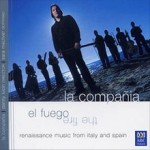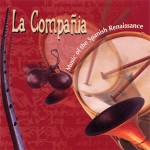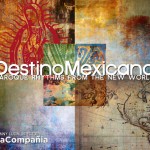 Destino Mexicano
Destino Mexicano
‘Baroque Rhythms from the New World’
LCR 4632 Fuse Group
“La Compañia go the whole hog here …on fruitily satisfying combinations of shawm, cornett, dulcians and sackbuts, backed up by bass viol, guitars and percussion …excellent recorded sound” Gramophone, UK
“What characterizes the ensemble’s sound is its rhythmic vivaciousness .. La Compañia’s performances, which are consistently idiomatic, light, colourful and rhythmic” International Record Review, UK
“two recordings by the Australian ensemble La Compañía, directed by the cornettist Danny Lucin …They are well played, with tasteful ornamentation Early Music (Oxford Journals) OUP, UK
“one finds oneself nicely rocking out …The recording quality of the disc is outstanding, and one will feel literally swept away by the jaunty rhythms of the music” Fanfare, US
“this superb Australian- based ensemble has done it again …its approach is in its unique blend of precision and flexibility …is imaginative and engaging throughout” Limelight
“Again, the playing is refined: perfect in intonation, balance and blend. …This recording is a delight …and excellence of performance which it offers is outstanding.” Historic Brass Society, US


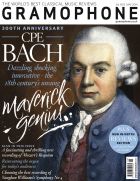 Having touched briefly on New World repertoire in their previous release ‘Ay Portugal’, Melbourne-based ensemble La Compañia go the whole hog here with a disc of music from late-Renaissance Mexico (with two Peruvian exceptions). Consisting of catchily cheerful villancicos and other short pieces on lightly borne sacred subjects by cathedral musicians of European origin such as Gaspar Fernandes, Juan Gutiérrez de Padilla and Juan de Araujo, but reflecting local styles, preoccupations and even languages, this is the kind of South American repertoire that Isabel Palacios’s Camerata de Caracas enjoyably brought to light in the 1990s (A/00), and which has since been successfully promoted over three CDs by Ex Cathedra (8/03, 6/08). (It should not to be confused, however, with the more staid stuff of Florilegium’s ‘Bolivian Baroque’ discs.)
Having touched briefly on New World repertoire in their previous release ‘Ay Portugal’, Melbourne-based ensemble La Compañia go the whole hog here with a disc of music from late-Renaissance Mexico (with two Peruvian exceptions). Consisting of catchily cheerful villancicos and other short pieces on lightly borne sacred subjects by cathedral musicians of European origin such as Gaspar Fernandes, Juan Gutiérrez de Padilla and Juan de Araujo, but reflecting local styles, preoccupations and even languages, this is the kind of South American repertoire that Isabel Palacios’s Camerata de Caracas enjoyably brought to light in the 1990s (A/00), and which has since been successfully promoted over three CDs by Ex Cathedra (8/03, 6/08). (It should not to be confused, however, with the more staid stuff of Florilegium’s ‘Bolivian Baroque’ discs.)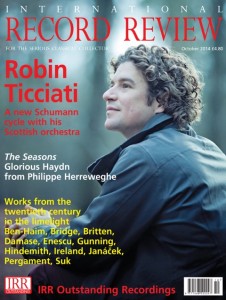 This is the third disc by the Australian ensemble La Compañia: the first was
This is the third disc by the Australian ensemble La Compañia: the first was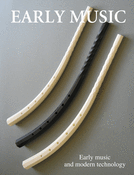 To start with, two recordings by the Australian ensemble La Compañía, directed by the cornettist Danny Lucin. The medium here is essentially the wind band (cornetts, sackbuts, dulcians) with viola da gamba, guitar, percussion and vocal soloists… The soloists on La Compañía’s more recent recording Destino Mexico: Baroque rhythms from the New World (La Compañía Records LCR 4632) are the soprano Lotte Betts-Dean and tenor Daniel Thomson. This CD focuses even more on Fernandes’s villancicos, some of them, such as Pois con tanta graça, performed instrumentally. They are well played, with tasteful ornamentation.
To start with, two recordings by the Australian ensemble La Compañía, directed by the cornettist Danny Lucin. The medium here is essentially the wind band (cornetts, sackbuts, dulcians) with viola da gamba, guitar, percussion and vocal soloists… The soloists on La Compañía’s more recent recording Destino Mexico: Baroque rhythms from the New World (La Compañía Records LCR 4632) are the soprano Lotte Betts-Dean and tenor Daniel Thomson. This CD focuses even more on Fernandes’s villancicos, some of them, such as Pois con tanta graça, performed instrumentally. They are well played, with tasteful ornamentation.
 The main genre was the villancico, a sort of narrative work of which individual instances could be combined together to form a larger musical entertainment. Of course, beginning even in the 18th century it began to be equated with Christmas music, but here the use is broader and more generic. Danny Lucin seems to have worked from the notion that this genre was the perfect one within which to insert a performance practice that reflects the folk rhythms and indigenous rhythms and instru- mentation. There has been debate about this, but there is nothing awkward or primitive in these works as performed by La Compañia—just the opposite, for early Baroque pieces the jauntiness and nice harmonies are infectious. Indeed, the opening gambit is the chaconne “A la vida bona” or to the good life. With its almost calypso-like rhythms and the weaving of the two voices describing the joys of life, one finds oneself nicely rocking out. The Nahuatl piece by Franco has a cornett and sackbut doing some nice counterpoint in the introduction, sort of like a Lutheran chorale (the real Luther ver- sion) gone mad. The voices have a weaving integrated contrapuntal line, and thus, native or not, Franco demonstrates he was well aware of part writing. The Fernandes “Tururu farara” has jazz-like rhythm for the fanfares, and it seems like an early Renaissance piece gone native with a nice per- cussive backdrop. And if this is not enough, the Gutiérrez “A la xácara xacarilla” throws the dance rhythms of the jacarilla, a popular Peruvian pastime, into the mix. Fernandes’s “Fransiquiya donde vamo” sounds very much indebted to the madrigal, but with a nice lyrical line (in imitation, as well) that is jagged, rhythmically active, and quite effective. When one figures in the vocal duet, a more interesting texture results with the various parallel harmonies. With “Hanacpachap cussicuinen,” we seem far from the Viceroyalty of New Spain and almost transported back to the realm of the Incan emperors, though of course with thoroughly European instruments. The steady beat of the drum gives it a march-like quality, and one might fantasize about litters of royalty being carried about. The final piece by Garcia seems as if it could have been written by someone more familiar with the Choralis Constantinus tradition of Heinrich Isaac, a nice benediction hymn which surprisingly devolves into a rather rollicking native dance…
The main genre was the villancico, a sort of narrative work of which individual instances could be combined together to form a larger musical entertainment. Of course, beginning even in the 18th century it began to be equated with Christmas music, but here the use is broader and more generic. Danny Lucin seems to have worked from the notion that this genre was the perfect one within which to insert a performance practice that reflects the folk rhythms and indigenous rhythms and instru- mentation. There has been debate about this, but there is nothing awkward or primitive in these works as performed by La Compañia—just the opposite, for early Baroque pieces the jauntiness and nice harmonies are infectious. Indeed, the opening gambit is the chaconne “A la vida bona” or to the good life. With its almost calypso-like rhythms and the weaving of the two voices describing the joys of life, one finds oneself nicely rocking out. The Nahuatl piece by Franco has a cornett and sackbut doing some nice counterpoint in the introduction, sort of like a Lutheran chorale (the real Luther ver- sion) gone mad. The voices have a weaving integrated contrapuntal line, and thus, native or not, Franco demonstrates he was well aware of part writing. The Fernandes “Tururu farara” has jazz-like rhythm for the fanfares, and it seems like an early Renaissance piece gone native with a nice per- cussive backdrop. And if this is not enough, the Gutiérrez “A la xácara xacarilla” throws the dance rhythms of the jacarilla, a popular Peruvian pastime, into the mix. Fernandes’s “Fransiquiya donde vamo” sounds very much indebted to the madrigal, but with a nice lyrical line (in imitation, as well) that is jagged, rhythmically active, and quite effective. When one figures in the vocal duet, a more interesting texture results with the various parallel harmonies. With “Hanacpachap cussicuinen,” we seem far from the Viceroyalty of New Spain and almost transported back to the realm of the Incan emperors, though of course with thoroughly European instruments. The steady beat of the drum gives it a march-like quality, and one might fantasize about litters of royalty being carried about. The final piece by Garcia seems as if it could have been written by someone more familiar with the Choralis Constantinus tradition of Heinrich Isaac, a nice benediction hymn which surprisingly devolves into a rather rollicking native dance… Aussie-based ensemble proves spicier than chili con carne
Aussie-based ensemble proves spicier than chili con carne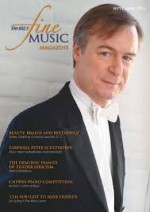 Music of the 16th century acquires a new sound for listeners attuned to Baroque and Renaissance music of European origin in the latest recording by La Compania, an ensemble based in Australia whose spiritual home lies far away in the New Worlds of America and Mexico. It is a world described musically in songs and dances. in religious reflections and rural ruminations, such as the 15 examples recorded here, all but half of them ascribed to composer Gaspar Fernandes, obviously a leading light of his time. The nine musicians and two singers named in the ensemble use their sackbuts dulcians, voices. whatever. to create sounds that should be comfort- able for Baroque music fans and if the New World is not entirely familiar territory to start with, it is easy enough to get used to. The CD comes with a very helpful booklet which describes the historic background to these works, explains all the tracks and includes the words to all the songs. an excellent read even as you are getting used to how it all sounds. The musicianship is everything you would expect, and all in all this is a superbly executed and produced revelation for any- one not accustomed to music La Compania- style, who would like to hear more of it.
Music of the 16th century acquires a new sound for listeners attuned to Baroque and Renaissance music of European origin in the latest recording by La Compania, an ensemble based in Australia whose spiritual home lies far away in the New Worlds of America and Mexico. It is a world described musically in songs and dances. in religious reflections and rural ruminations, such as the 15 examples recorded here, all but half of them ascribed to composer Gaspar Fernandes, obviously a leading light of his time. The nine musicians and two singers named in the ensemble use their sackbuts dulcians, voices. whatever. to create sounds that should be comfort- able for Baroque music fans and if the New World is not entirely familiar territory to start with, it is easy enough to get used to. The CD comes with a very helpful booklet which describes the historic background to these works, explains all the tracks and includes the words to all the songs. an excellent read even as you are getting used to how it all sounds. The musicianship is everything you would expect, and all in all this is a superbly executed and produced revelation for any- one not accustomed to music La Compania- style, who would like to hear more of it.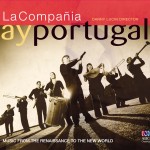
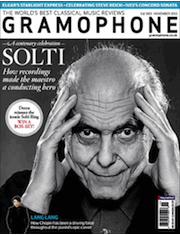 Australians explore music from Renaissance Iberia
Australians explore music from Renaissance Iberia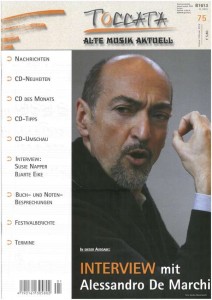 La Compania previous CD release of renaissance music from the Iberian Peninsula was El fuego (ABC Classics, Toccata Tip 48/2010). The ensemble continues here in this style with works by Gaspar Fernandes (who worked in Guatemala and Mexico) Manuel Machado, Pedro de Cristo, Francisco Guerrero, Luis de Milan and Pedro de Escobar, this Renaissance music thrives on improvisation, rhythms and dynamic ornamentation requiring exceptional mastery of the instrument, matched by musicality. And this is exactly what the Australians display. From the beginning an exciting pulse consistently demonstrated throughout, joyful ornamented music with such security in style that is only achieved by the masters in the field. In this way the quality of the composition is not merely conveyed but blossoms with the vast variation, in colorfully adorned sound enriched by sterling Interpretation.
La Compania previous CD release of renaissance music from the Iberian Peninsula was El fuego (ABC Classics, Toccata Tip 48/2010). The ensemble continues here in this style with works by Gaspar Fernandes (who worked in Guatemala and Mexico) Manuel Machado, Pedro de Cristo, Francisco Guerrero, Luis de Milan and Pedro de Escobar, this Renaissance music thrives on improvisation, rhythms and dynamic ornamentation requiring exceptional mastery of the instrument, matched by musicality. And this is exactly what the Australians display. From the beginning an exciting pulse consistently demonstrated throughout, joyful ornamented music with such security in style that is only achieved by the masters in the field. In this way the quality of the composition is not merely conveyed but blossoms with the vast variation, in colorfully adorned sound enriched by sterling Interpretation.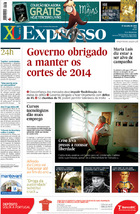
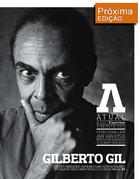
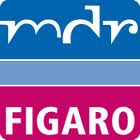
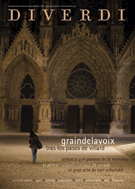 This publication takes us to the period in which Portugal became part of the Spanish crown and many of its composers undertook their work in Spanish territories of the old and new worlds. As well as these, there are works by Guerrero and Milan. The general tone of the repertoire is festive, with secular villancicos and sacred villanescas. Of the vocal works included in the disc, half are transcribed for instruments.
This publication takes us to the period in which Portugal became part of the Spanish crown and many of its composers undertook their work in Spanish territories of the old and new worlds. As well as these, there are works by Guerrero and Milan. The general tone of the repertoire is festive, with secular villancicos and sacred villanescas. Of the vocal works included in the disc, half are transcribed for instruments.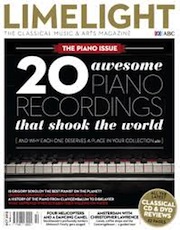 AY, CARAMBA, THEY’RE GOOD!
AY, CARAMBA, THEY’RE GOOD!

